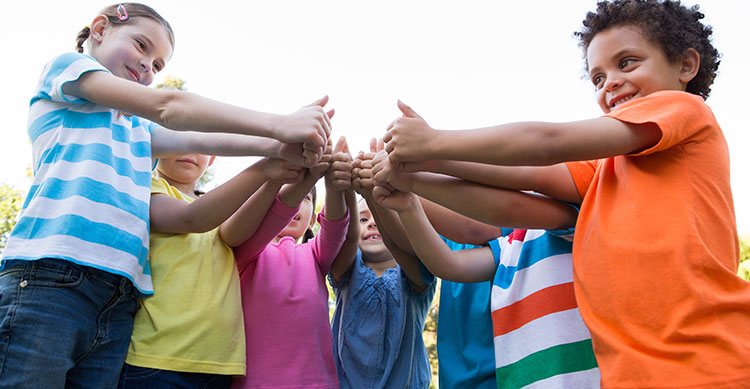B5: Rhyme & Movement
1. Overview
In this multisensory activity, a group of children will use nursery rhymes and movement to focus their attention on the rhyming words.
B5: Rhyme & Movement
2. Materials
For this activity you will need the text for a variety of nursery rhymes. Here are a few that we recommend:- Girls and Boys, Come Out to Play
- Jack Be Nimble
- Baa, Baa, Black Sheep
- Mary Had a Little Lamb
- One, Two, Buckle My Shoe
- One, Two, Three, Four, Five
- Sing a Song of Sixpence
- To Market, To Market
- Little Boy Blue
- Hickory Dickory Dock
3. Activity
Video: How to play Rhyme & Movement
Have the children sit in a circle and hold their fists in front of them, one fist on each knee. Select one child to be “it.” While you recite the selected nursery rhyme (in this example, “Hickory Dickory Dock”), the child who is “it” will walk around the inside of the circle, tapping a fist on each stressed syllable you utter (the underlined syllables below).
Hickory dickory dock,
The mouse ran up the CLOCK.
The clock struck one,
The mouse did RUN,
Hickory dickory DOCK.
Hickory dickory dock,
The mouse ran up the CLOCK.
The clock struck two,
The mouse said “BOO!”
Hickory dickory DOCK.
Hickory dickory dock,
The mouse ran up the CLOCK.
The clock struck three,
The mouse said “WHEE!”
Hickory dickory DOCK.
On the second (or third) rhyming word (in all caps above) at the end of a line, the child whose fist was tapped on that word puts that hand behind her back. Keep going until only one fist remains — that child is the new “it.”
This game can be repeated with a variety of nursery rhymes.
4. Confidence Builder
If the child playing “it” is one who struggles with hearing rhymes, be sure to select a very simple poem with obvious rhymes for her. Reinforce this foundational skill before pushing on to more complex poems.5. Individual Variation
Instead of a circle of multiple children, one child can play this game (with adult guidance) with a circle of blocks, counters, etc. As you say the rhyme, have the child go around the circle, tapping and then removing blocks, until only one remains.6. Small Groups (2-5 children)
Lesson Objective: Children will be able to identify and respond to one-syllable words that rhyme. GELDS (Georgia Early Learning & Development Standards): CLL6.3a (Activities for this standard will be increased in difficulty to match children’s age.) Georgia Standards of Excellence: ELAGSEKRF2.a Common Core State Standards: CCSS.ELA-LITERACY.RF.K.2.A Additional Materials:- optional: book of nursery rhymes
Leave a Reply
